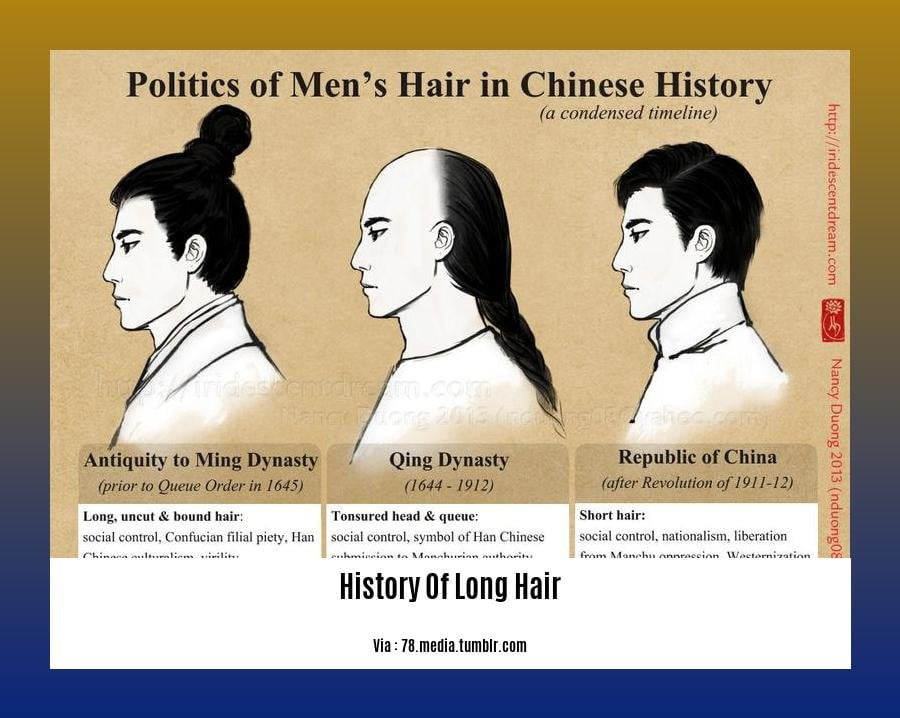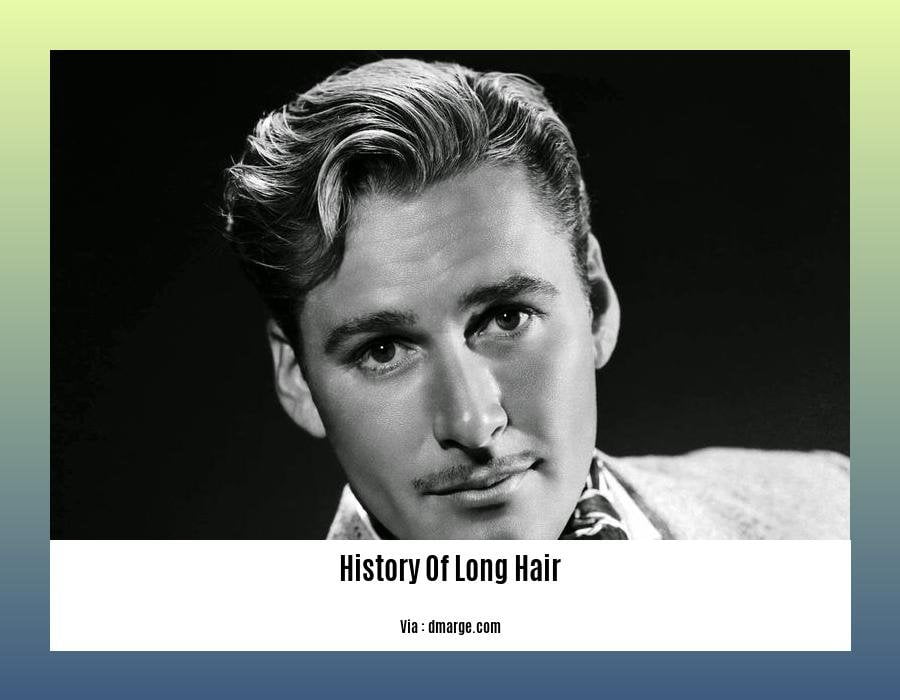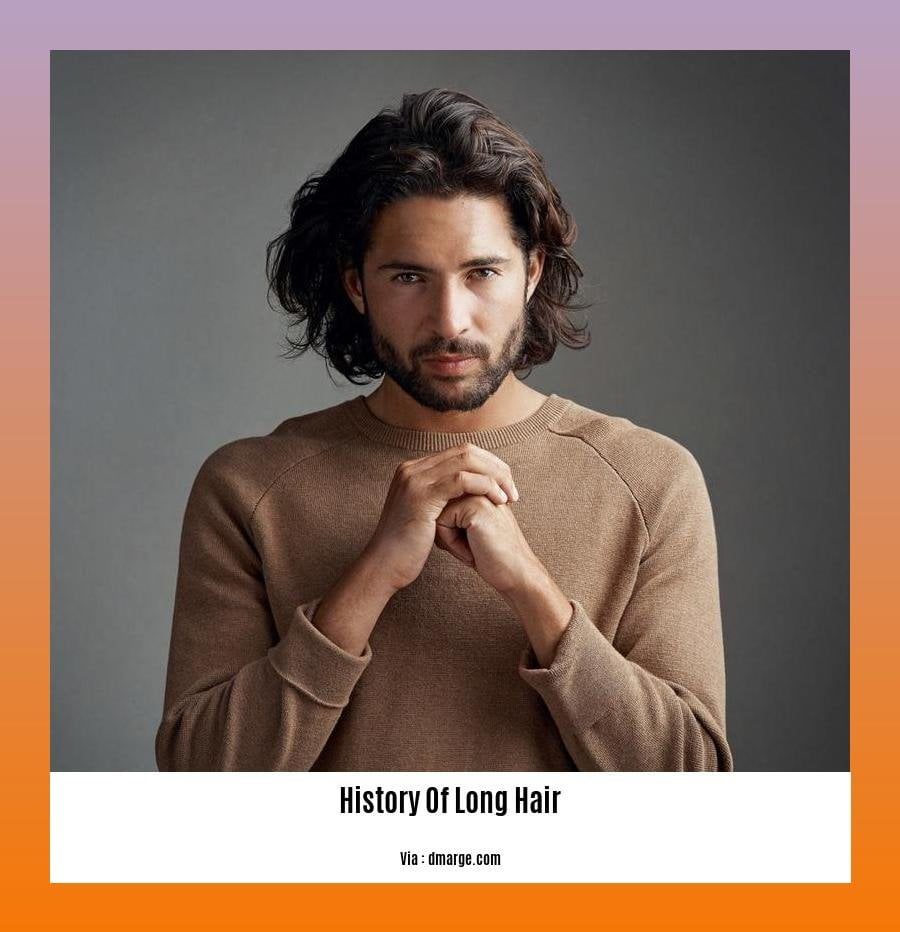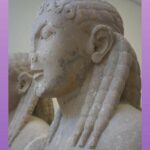Embark on a captivating journey through the annals of time as we explore the rich history of long hair in [Unveiling the History of Long Hair: Cultural, Social, and Political Perspectives]. From ancient civilizations to modern times, long hair has held profound significance, reflecting cultural norms, social conventions, and political power structures. Prepare to unravel the fascinating tales behind this enduring symbol of identity, expression, and cultural heritage.
Key Takeaways:
- Historically, long hair for women and short hair for men have been the norm.
- In ancient Greece, long hair for men represented wealth and authority, while short hair was reserved for slaves.
- Greek gods and heroes like Zeus, Achilles, Apollo, and Poseidon were frequently portrayed with long hair.
- In ancient Rome, long hair was seen as a symbol of virility and strength.
- During the Middle Ages, long hair was often associated with royalty and the nobility.
- In the 1960s, long hair became a symbol of rebellion and counterculture.
**The History of Long Hair: Cultural, Social, and Political Perspectives**

Long hair has captivated cultures worldwide for centuries, transcending mere aesthetics and evolving into a potent symbol of power, rebellion, and self-expression. Join us as we delve into its rich history, uncovering the captivating stories behind the locks that have shaped societies.
Ancient Greece: Long Hair as a Symbol of Power and Divinity
In ancient Greece, long hair held immense significance, particularly among men. It represented wealth, power, and virility, with gods and heroes like Zeus, Achilles, Apollo, and Poseidon often depicted with flowing locks. Short hair, on the other hand, was customary for slaves, signifying their subservient status.
Ancient Rome: Strength, Virility, and the Allure of Long Hair
Roman culture embraced long hair as a symbol of virility and strength. It was believed that long hair enhanced a man’s physical prowess and was a sign of good health. Roman emperors, known for their elaborate hairstyles, often sported long, well-groomed locks.
Middle Ages: Long Hair and the Aristocracy
During the Middle Ages, long hair became a hallmark of royalty and nobility. It was seen as a sign of high status and privilege, with elaborate hairstyles and intricate braids showcasing one’s wealth and power.
1960s: Long Hair as a Symbol of Rebellion and Counterculture
The 1960s witnessed a resurgence of long hair, this time as a symbol of rebellion and counterculture. Rejecting societal norms, young people embraced long hair as a way to express their individuality and challenge traditional values.
Long Hair Today: A Testament to Diversity and Personal Expression
In contemporary times, long hair has become a symbol of personal expression and diversity. It is no longer confined to specific genders or social classes but is embraced by individuals across the globe, reflecting their unique styles and personalities.
The history of long hair is a testament to its enduring power as a cultural symbol, evolving through the ages to reflect the values, beliefs, and aspirations of different societies. Whether as a symbol of power, rebellion, or personal expression, long hair continues to captivate and inspire, leaving an indelible mark on the tapestry of human history.
Uncover the captivating history behind the humble light switch, an everyday object that changed history. History of Light Switches
Explore the remarkable journey of Little League Baseball, from its humble beginnings to its global impact, and its stories of triumph and determination. History of Little League Baseball
Dive into the intricate history of macrame, a beautiful and enduring art form, and discover how it evolved from ancient traditions to modern creative expression. History of Macrame
In the Middle Ages, Long Hair Was Seen as a Sign of Wealth and Status, and Was Often Worn by Royalty and Nobles.

In medieval times, hair was more than just a fashion statement—it was a potent symbol that spoke volumes about one’s station in life.
From a young age, people understood that long, flowing locks were a sign of prestige and elevated rank. While the style may have differed, the message it conveyed was consistent: you were someone of importance.
Kings and queens adorned themselves with intricately braided and bejeweled tresses that cascaded over their shoulders. These elaborate hairstyles were symbols of their power and authority. Elaborate hairstyles, often adorned with jewels or intricate braids, were a testament to their status as rulers.
The nobility followed suit, adopting long hairstyles that signaled their privileged positions. Length was everything, as it required resources and time to maintain those luxurious locks.
But why was long hair so highly valued in medieval society?
Practicality: In an era where bathing was infrequent, long hair offered insulation against the cold and protection from the elements. That thick mane provided warmth and protection from the harsh medieval climate.
Hygiene: Frequent washing wasn’t a priority, so long hair was seen as a way to manage dirt and lice. Who needs a shampoo when you can just let your hair down, literally?
Fashion: Let’s be honest, long hair was in vogue. It was the ultimate medieval accessory, a symbol of beauty and sophistication. When you had long, luscious locks, you were the envy of the town.
Key Takeaways:
In the Middle Ages, long hair held deep cultural significance, reflecting one’s age, sex, ethnicity, and social status.
Long hair was associated with youth and wealth, making it a hallmark of the nobility and royalty.
Elaborate hairstyles, often adorned with jewels or intricate braids, showcased power and authority.
Practicality, hygiene, and fashion converged to make long hair a coveted status symbol in medieval society.
Wearing long hair was a way to show off one’s social standing and distinguish oneself from the lower classes.
Hairstyles varied across different cultures and regions, with the Normans being known for their long hair, while the Anglo-Saxons typically wore shorter hair.
Citations:
Symbolic Meanings of Hair in the Middle Ages
In the 19th Century, Long Hair Became a Symbol of Rebellion and Individuality, and Was Often Worn by Artists and Intellectuals
In the Victorian era, long hair was considered unconventional and even rebellious. It challenged the societal norms that dictated shorter, more conservative hairstyles. Artists and intellectuals embraced long hair as a symbol of individuality and nonconformity, setting themselves apart from the mainstream.
Their rejection of societal expectations extended beyond hairstyles. They challenged traditional values, questioned established norms, and pushed boundaries in their creative pursuits. This spirit of rebellion was reflected in their appearance, including their distinctive long hair.
Key Takeaways:
In the 19th century, long hair defied societal expectations and symbolized rebellion against traditional norms.
Artists and intellectuals embraced long hair as a symbol of individuality and nonconformity.
The adoption of long hair represented their rejection of societal conformity and their commitment to creative freedom.
Long hair became a symbol of individuality and nonconformity, challenging the societal norms that dictated shorter, more conservative hairstyles.
The bohemian lifestyle associated with long hair was often associated with nonconformity and a rejection of traditional values.
Sources:
Long Hair in the 19th Century: A Symbol of Rebellion and Individuality
The History of Long Hair: From Symbol of Rebellion to Symbol of Style
In the 20th century, long hair became more widely accepted, and is now worn by people of all ages and backgrounds.
During the 20th century, hairstyles became more diverse and expressive than ever before, with long hair emerging as a popular choice for individuals of all ages and backgrounds. This shift was driven by several cultural, social, and political factors that challenged traditional norms and encouraged personal expression.
One key factor was the changing roles and freedoms for women. As women gained more independence and autonomy, they sought hairstyles that reflected their newfound sense of liberation. Long hair became a symbol of femininity and individuality, allowing women to break free from the restrictive norms of the past.
The rise of countercultural movements in the 1960s further contributed to the acceptance of long hair. Young people embraced long hair as a way to rebel against societal expectations and express their individuality. It became a symbol of nonconformity, creativity, and a desire to challenge the status quo.
Moreover, the influence of popular culture played a significant role in promoting long hair. Film stars, musicians, and other celebrities often sported long hairstyles, which influenced fashion trends and made long hair more desirable. This visibility helped to normalize long hair and make it more acceptable in mainstream society.
As a result of these cultural, social, and political shifts, long hair became widely accepted and embraced by people of all ages and backgrounds in the 20th century. It continues to be a popular choice today, symbolizing personal style, freedom of expression, and a connection to different cultural and historical influences.
Key Takeaways:
- In the 20th century, changing roles and freedoms for women led to a rise in diverse hairstyles, including the acceptance of long hair.
- Long hair became a symbol of femininity and individuality, allowing women to break free from traditional norms.
- Countercultural movements in the 1960s embraced long hair as a symbol of rebellion and nonconformity.
- The influence of popular culture, including celebrities and fashion trends, helped to normalize long hair in mainstream society.
- Today, long hair is widely accepted and worn by people of all ages and backgrounds, representing personal style, freedom of expression, and cultural connections.
Sources:
– https://www.dazeddigital.com/beauty/article/61194/1/history-of-long-hair
–
FAQ
Q1: What cultural factors influenced the significance of long hair in ancient Greece?
A1: In ancient Greece, long male hair symbolized wealth and power, while short hair was appropriate for slaves. Greek gods and heroes such as Zeus, Achilles, Apollo, and Poseidon were often depicted with long hair, reflecting their elevated status and strength.
Q2: How did long hair symbolize virility and strength in ancient Rome?
A2: In ancient Rome, long hair was considered a sign of virility and strength. Roman soldiers often wore their hair long as a symbol of their masculinity and prowess in battle.
Q3: During the Middle Ages, what social distinctions were denoted by hair length?
A3: In the Middle Ages, hair length carried symbolic meanings and served to denote differences in age, sex, ethnicity, and social status. Long hair was associated with youth, while short hair was associated with maturity and old age. Women typically wore their hair long and loose, while men wore it short and trimmed. Hair length also had an ethnic dimension; the Normans, for example, were known for their long hair, while the Anglo-Saxons typically wore shorter hair.
Q4: What was the significance of long hair for women in Victorian England?
A4: In the mid-1800s, long hair was considered a beauty attribute for European women, and Victorian women were expected to grow their hair as long as possible. Long hair was seen as a symbol of femininity, modesty, and adherence to societal norms.
Q5: How did the 1960s counterculture movement influence hairstyles?
A5: In the 1960s, long hair became a symbol of rebellion and counterculture. Rejecting traditional societal norms, many young people, particularly those involved in the hippie movement, grew their hair long as a statement of individuality, freedom, and nonconformity. Long hair became a symbol of peace, love, and resistance to the establishment.
- Discover Long Black Pepper: Flavor & Health Benefits - April 25, 2025
- Shocking Twists: The Grownup Review: Unreliable Narration - April 25, 2025
- A Quiet Place Book vs Movie: A Deep Dive - April 25, 2025
















